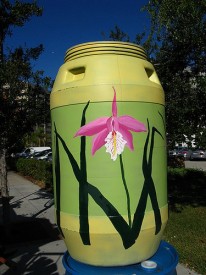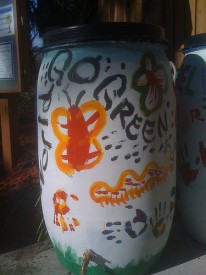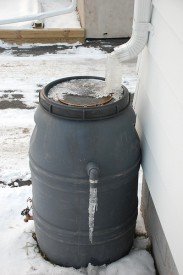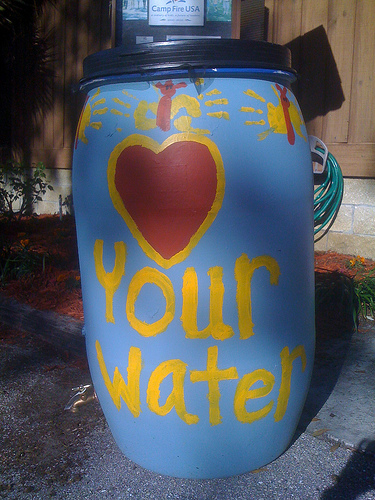You hooked up a 55-gallon rain barrel to one of your roof downspouts. You were glad — maybe even a little smug — about tapping that free water to keep some of your plants happy this summer.
Are you ready to kick it up a notch?
There’s increasing interest around the Northwest in rainwater harvest on a bigger, bolder scale. Stretch that little rain barrel into a 550-gallon cistern installed above ground or below. Or don’t stop there — how about vessels holding 1,000 gallons, 10,000 gallons — to catch all that lovely rain. The bigger the better. After all, the uses are endless and our rain supply is generous during most seasons.
So far, Oregon has been a big step ahead of Washington in encouraging and permitting the capture and use of rainwater and next week, Portland is hosting the 2011 American Rainwater Catchment System Association (ARCSA) Conference.

Examples of rainwater collection spring up around Oregon. A nursery in Clackamas County is installing a 309,000 gallon cistern to water its leafy inventory. Five cisterns storing 24,000 gallons of water in Columbia EcoVillage, a sustainability-oriented Portland community, are used to water their extensive veggie gardens. A Portland elementary school has a 1,750-gallon underground rainwater catchment system for irrigation. On the home front, Anita Van Asperdt and Eimar Boesjes boast a partially buried, 8,000-gallon cistern at their Eugene residence.
But irrigation is only half the story. Oregon residents, businesses, and developers are looking to rainwater to flush toilets, wash laundry, take showers, and in some cases, even to drink. And with the sort of rainfall we get in the Northwest, the precipitation can actually provide for all of those uses. With an average of 37 inches of annual rainfall, the typical Portland residential roof generates about 30,000 gallons of runoff every year (that stat and great rain barrel how-to info comes from this city of Portland handout). That’s a lot of showers, even long showers!
Besides conserving water, rain barrels and cisterns reduce the flow of polluted runoff that erodes stream banks and floods basements, and flushes toxic chemicals into rivers and lakes harming salmon and other aquatic life.
Folks contemplating bringing the rain inside for reuse can look to Portland for inspiration. Back in 1996, the city gave its first permit for rainwater harvest for potable uses such as drinking and cooking to “urban ecologist innovators” Ole and Maitri Ersson. The couple built a 1,500-gallon system to collect and purify rainwater for all of their water-related needs. Their setup harvests 27,000 gallons a year, though the Erssons switch to city-provided water during Portland’s summer drought.

Others have followed suit. Pacific University’s Gilbert Hall dorm and its health building both have systems to reuse rainwater. The 150-resident dorm in Forest Grove has a 12,000-gallon storage tank buried underground. That water is pumped to a 500-gallon tank in the building’s basement and that supplies water for flushing toilets. “Gilbert’s reuse of rain water, coupled with low-flow toilets and efficient showerheads, saves 784,000 gallons of water a year,” reported a story last year in Estacada News.
For Oregonians interested in rainwater harvest, no permits are needed to hook a rain barrel to your downspout to water plants. If you want to bring that water inside, Portland requires a permit for residential non-potable uses (toilets, laundry, etc.). If you want to drink the water, you have to file for a permit appeal.The city explains:
It’s not an adversarial appeal, more like a way to be sure an applicant has really thought through the installation. Also, that you understand the commitment–once water pipes have been used for rainwater they can’t be converted back to city water.
There are additional regulations if you want to use rainwater inside commercial buildings or apartment buildings and condos.
And there are monetary incentives, besides what you save on your water bill. In Portland, depending on where you live, you can get paid to disconnect your downspout from the stormwater system. Also, if Portlanders keep their stormwater onsite in rain barrels or by using other green stormwater strategies, they can get a discount on their utility bill.
Washington and its cities and counties have been working to improve regulations and incentives to harvest rainwater, but it’s been slow going. It wasn’t until October 2009 that the Washington Department of Ecology declared that rainwater could indeed legally be collected from your roof (see this fab Sightline blog post explaining why it took so long). And it was finally this July that King County approved rules allowing rainwater to serve as a home’s sole source for potable water.
While it doesn’t take much smarts to figure out how to hook up a rain barrel to a downspout, getting that water inside and making sure it’s clean enough for different uses definitely takes some expertise. But there’s plenty of great info out there to get started figuring out how rain harvesting works and what kind of system you might want.
So bring on the rain that defines the beautiful North-wet!

Oregon and Washington rain harvest resources:
- The rain harvest info clearinghouse: HarvestH20.com
- Great basic rain harvest info from Clackamas County and a nice how-to guide from Oregon’s Building Codes Division
- Interesting how-to article and water-by-the-numbers stats from the Oregonian (Did you know 30 percent of the water used in a home is for drinking and cooking, while 70 percent is used for showers, toilets, laundry, landscape and other nonpotable uses?)
- Oregon rainwater catchment incentives
- Oregon rainwater catchment regulations
- Washington incentives
- Washington regulations, and also here from the Department of Ecology


Comments are closed.